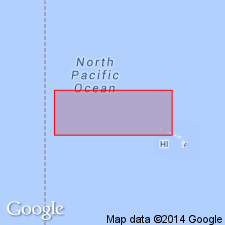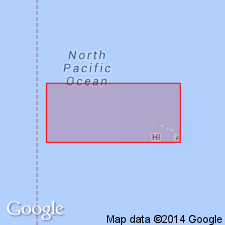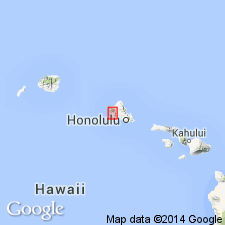
- Usage in publication:
-
- Mauna Kuwale Trachyte
- Modifications:
-
- Geochronologic dating
- AAPG geologic province:
-
- Oahu
Summary:
Rocks included in lower Waianae series by Stearns (1935) who regarded series as oldest exposed rocks of Oahu. Conformably underlies to south-southwest basalts mapped as lower and (or) middle Waianae series (Macdonald, 1940). Thickness about 400 ft. K-Ar age for hornblende-biotite-trachyte from Mauna Kuwale flow gave 8.4 +/-0.2 Ma "corresponding to the lower to middle Pliocene based on time scale of Kulp [1961]".
Source: GNU records (USGS DDS-6; Menlo GNULEX).

- Usage in publication:
-
- Mauna Kuwale trachyte
- Modifications:
-
- Geochronologic dating
- AAPG geologic province:
-
- Oahu
Summary:
K-Ar ages on minerals and whole rock from rhyodacite of Mauna Kuwale give 2.3 +/-0.3 Ma. Authors discuss reasons for anomalous old age for previous studies.
Source: GNU records (USGS DDS-6; Menlo GNULEX).

- Usage in publication:
-
- Mauna Kuwale Rhyodacite Flow*
- Modifications:
-
- Named
- Overview
- Dominant lithology:
-
- Rhyodacite
- AAPG geologic province:
-
- Oahu
Summary:
Named for Mauna Kuwale Ridge, Waianae Range, Island of Oahu HI. Type section: ridge immediately northeast of Mauna Kuwale [21 deg 28' 01N, 158 deg 09' 01"W, Waianae 7.5' quad]. Flow is included in Kamaileunu Member (new) of Waianae Volcanics. Formerly considered to be trachyte and included in various members of Waianae Volcanic Series: lower member (Stearns, IN Stearns and Vaksvik, 1935); middle member (Stearns, 1946; Macdonald, 1949); and upper member (Macdonald, 1940). McDougall (1963) called flow Mauna Kuwale Trachyte, separate unit on basis of much older K-Ar age of 8.4 Ma. Funkhouser and others (1966) concluded that K-Ar determination was more nearly 2.3 +/-0.4 Ma and that 8.4 Ma determination could be caused by excess argon retention. Consists of highly distinctive glassy, hornblende-biotite-hypersthene rhyodacite, unique lithology unknown elsewhere in HI. Is about 62 m thick at type section and 45 to 111 m thick at Mauna Kuwale Ridge. Overlies icelandite; underlies basaltic hawaiite of Kamaileunu Member (new) at Mauna Kuwale Ridge. Age is "still in question but a minimum age of 3.2 Ma is consistent with the other data."
Source: GNU records (USGS DDS-6; Menlo GNULEX).
For more information, please contact Nancy Stamm, Geologic Names Committee Secretary.
Asterisk (*) indicates published by U.S. Geological Survey authors.
"No current usage" (†) implies that a name has been abandoned or has fallen into disuse. Former usage and, if known, replacement name given in parentheses ( ).
Slash (/) indicates name conflicts with nomenclatural guidelines (CSN, 1933; ACSN, 1961, 1970; NACSN, 1983, 2005, 2021). May be explained within brackets ([ ]).

